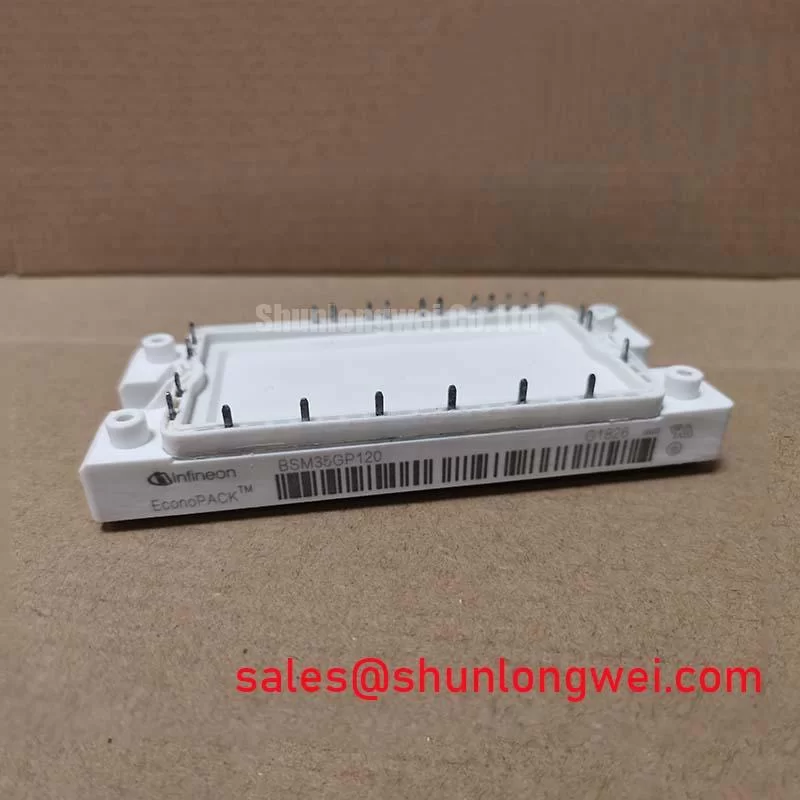BSM35GP120 IGBT Module: An Integrated Solution for Power Converters
## BSM35GP120 IGBT Module: 1200V, 35A for Power Converters
Introduction and Core Highlights
The Infineon BSM35GP120 is a Power Integrated Module (PIM) that integrates a three-phase input rectifier, a brake chopper, and a three-phase inverter in a single housing. Its defining characteristic is the balanced integration of low conduction losses and robust thermal performance, making it a reliable foundation for variable frequency drives and other power conversion systems. This module simplifies system design by consolidating key power stages into one component.
* **Core Specifications**: 1200V | 35A (Inverter IGBT) | VCE(sat) (typ) 2.2V
* **Key Advantages**: Reduces component count and assembly complexity, integrated NTC for temperature monitoring enhances system reliability.
* **Engineering Focus**: Provides a compact, all-in-one solution for motor drive applications, streamlining thermal management and mechanical layout.
Download Official Datasheet (PDF)


Technical Analysis of the Integrated Design
The primary value of the BSM35GP120 lies in its high level of integration. By combining the rectifier, brake chopper, and inverter stages, the module significantly reduces the parasitic inductance that typically occurs in systems built from discrete components. Lower parasitic inductance leads to reduced voltage overshoots during high-speed switching events, which enhances the reliability of the entire system. This integration simplifies PCB layout and often diminishes the need for complex Snubber Circuit designs, accelerating the development cycle for power electronics.
Another critical engineering aspect is the module’s thermal design. The datasheet specifies the thermal resistance from junction to case (RthJC) for both the IGBTs and diodes. Think of thermal resistance as the width of a pipe for heat; a lower value indicates a wider pipe, allowing heat to escape more easily from the semiconductor junction to the heatsink. The low thermal resistance values specified for the BSM35GP120 ensure efficient heat dissipation, which is crucial for maintaining the device’s operating temperature within the safe operating area (SOA) under heavy loads. This is further supported by an integrated NTC thermistor, providing real-time temperature feedback for precise thermal control and protection.
Optimized Application Scenarios
This module is specifically well-suited for applications that benefit from its all-in-one configuration.
* **AC Motor Drives**: Its integrated three-phase inverter is the core of a Variable Frequency Drive (VFD), providing precise control over motor speed and torque. The built-in brake chopper is ideal for managing regenerative energy during deceleration.
* **Servo Drives**: The module’s performance supports the dynamic load changes and high-precision control required in industrial automation and robotics.
* **Uninterruptible Power Supplies (UPS)**: The consolidated power stages enable the design of compact and efficient UPS systems, where reliability and power density are paramount.
* **Air Conditioning Systems**: Used in the inverter stage of modern air conditioners to efficiently control the compressor motor speed, reducing energy consumption.
The BSM35GP120 is the optimal choice for mid-power motor control systems where reducing design complexity and improving reliability are key project goals.
Key Specification Parameters
| Inverter IGBT: Absolute Maximum Ratings (per switch at Tc=25°C unless otherwise noted) | |
|---|---|
| Collector-Emitter Voltage (VCES) | 1200 V |
| DC Collector Current (IC) @ Tc=80°C | 35 A |
| Repetitive Peak Collector Current (ICRM) | 70 A |
| Total Power Dissipation (Ptot) | 230 W |
| Inverter IGBT: Electrical Characteristics (per switch at Tvj=25°C) | |
| Collector-Emitter Saturation Voltage (VCE(sat)) @ IC=35A, VGE=15V | 2.2 V (typ), 2.7 V (max) |
| Gate-Emitter Threshold Voltage (VGE(th)) | 5.0V to 6.5V |
| Thermal and Mechanical Specifications | |
| Operating Junction Temperature (Tvj op) | -40 to +125 °C |
| Max. Junction Temperature (Tvj max) | 150 °C |
| Isolation Voltage (Visol) | 2500 V (AC, 1 min) |
Engineer FAQ
1. Why is a Power Integrated Module (PIM) like the BSM35GP120 often preferred over discrete components for motor drives?
A PIM combines multiple power stages into a single, factory-tested module. This approach minimizes parasitic inductance, simplifies the thermal interface to the heatsink, reduces assembly time, and improves the overall reliability and power density of the final system.
2. What is the function of the NTC thermistor inside the BSM35GP120?
The integrated NTC (Negative Temperature Coefficient) thermistor provides a means for real-time temperature monitoring of the module’s baseplate. A gate drive or control circuit can read this resistance value to estimate the junction temperature, enabling over-temperature protection and ensuring the module operates within its specified thermal limits.
3. What are the recommended mounting torque specifications for this module?
The datasheet specifies a mounting torque for the M5 terminals and M6 mounting screws. Adhering to these values (typically between 2.5 – 5.0 Nm, but always confirm with the latest datasheet) is critical. Insufficient torque leads to poor thermal contact and overheating, while excessive torque can cause mechanical stress and damage the module’s substrate.
4. How does the VCE(sat) of 2.2V (typ) impact system design?
The collector-emitter saturation voltage, VCE(sat), is the voltage drop across the IGBT when it is fully on. A lower VCE(sat) directly translates to lower conduction losses (Power Loss = VCE(sat) * IC). The 2.2V typical value for the BSM35GP120 at its nominal current signifies efficient operation, which reduces the amount of waste heat that must be managed by the cooling system.
Enabling Compact and Reliable Power Systems
The BSM35GP120 provides a highly integrated and thermally efficient solution for power conversion. By consolidating the essential components of a motor drive into a single module, it empowers engineers to design systems that are not only more compact and faster to assemble but also inherently more reliable. This strategic integration is key to achieving performance targets in demanding industrial applications.